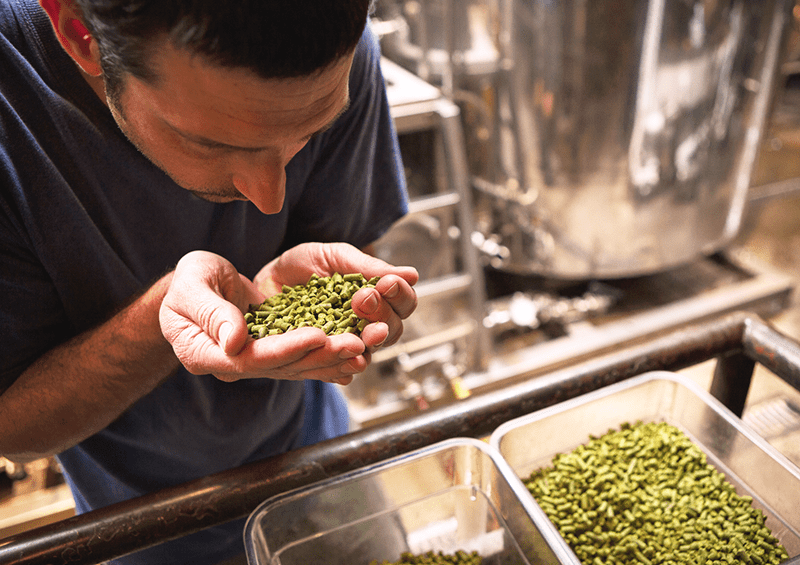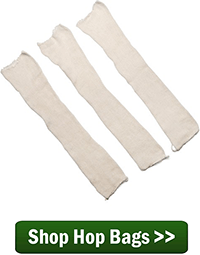 Our friend Bryan Roth recently shared some of the reasons that experimenting is a good homebrewing habit. In that pioneering spirit, here’s an experiment that will help you learn about how different hop aroma profiles and how they affect your beer.
Our friend Bryan Roth recently shared some of the reasons that experimenting is a good homebrewing habit. In that pioneering spirit, here’s an experiment that will help you learn about how different hop aroma profiles and how they affect your beer.
A quick refresher:
Hops have essential oils that contribute to beer aroma. When added at the end of the boil or to the secondary fermenter, these oils can develop aromas described as citrus, pine, spice, dark fruit, herbal, or floral, to name a few. A hop aroma wheel can be a useful tool for selecting appropriate hop varieties, but the best way to learn the different hop aroma profiles and what they can offer to your homebrew is to actually brew with them.
That said, with an endless number of hop varieties out there and more being released all the time, it could take years to brew all the beers it would take to get a complete understanding of different hop aroma profiles. In the experiment below, you can brew one batch of beer, then split it up after fermentation to dry hop with different hop varieties. This will expose you to different hop aroma profiles 5 times as fast as using a single hop variety.
- The equipment and ingredients for brewing one, five-gallon batch of pale ale
- Five different hop varieties (for example, Cascade, Simcoe, Centennial, Amarillo, and Citra are some popular American hops)
- Five, 1-gallon glass jugs
- Five, drilled, #6 rubber stoppers
- Five airlocks
- Suggested: Mini auto-siphon
Here’s how it works:
- Brew one batch of beer, but only use the first bittering addition during the boil.
- After primary fermentation, divide the batch into five, 1-gallon jugs and dry hop each jug with about 1/4 to 1/2 oz. of each hop variety. The exact amount isn’t as important as making sure you use the same amount for each 1-gallon batch. A typical dry hopping period lasts about 5-7 days.
- Bottle the beers, being sure to identify which are which.

- When the beer is ready, do a tasting session to identify the different hop aroma profiles and characteristics presented by each hop. Maybe try a blind tasting to figure out which is your favorite. Was it the one you expected?
- Share the beers with friends to see if they agree with your assessments. What seems like a pleasing citrus aroma for one person may be unpleasant for someone else.
- To take it a step further, try blending the beers to get a sense of what hop varieties work well together.
Learning the characteristics of your homebrewing ingredients is one of the best ways to become a better brewer. With experiments like this one, you can accelerate your way to becoming a true hop aficionado.
Have you tried some experiments with hops? Did you learn anything about hop aroma profiles?
—–
David Ackley is a beer writer, brewer, and self-described “craft beer crusader.” He holds a General Certificate in Brewing from the Institute of Brewing and Distilling and is founder of the Local Beer Blog.


Interesting to read this information about hops. I usually make beer from a kit. Maybe a couple of kits at a time. Recently I had an acquaintance send me 6 one gallon bags of different hops. Still in cones. I have no idea how to use them. Do I still get kits and substitute hops that I have? If so how much do I add? Do I need to extract it from the cone? I’ve tried to contact local brewers, but they never get back to me. Help???
Tim, if you are making beer from kits, our best advise would be not to alter them and use the ingredients and directions that come with the kit. If you want to use the hops your friend gave you, we would recommend finding a recipe to use. You will use the cone, not extract from the cone. You will use the amount by weight that the recipe calls for. Below we have provided a link to our beer recipes for more information.
Beer Recipes
http://www.eckraus.com/home-brew-beer-recipes